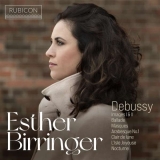Von Claude Debussys Klavierwerken gibt es eine solch große Anzahl hervorragender Einspielungen, insofern man sich bei jeder Neuaufnahme die Frage stellen muss, ob sie denn auch wirklich nötig ist. Im Falle von Esther Birringer muss man diese Frage eindeutig mit ‘ja’ beantworten. Denn im Gegensatz zu vielen Pianisten der ersten Garde, die sich mit einem nur professionellen Spiel begnügen, eröffnet Birringer neue Perspektiven. Debussys Musik ist verführerisch und darin liegt dann auch ihre große Gefahr, nämlich, dass sich der Interpret in dem unwahrscheinlichen Klangkosmos der Musik verliert. Esther Birringer löst die Konturen der Musik nicht auf, vielmehr arbeitet sie sich schichtweise an die Substanz, an die Emotionen und an die Farben heran. Konturen werden erhalten, bleiben aber immer flexibel und in Bewegung. Denn die Pianistin zögert nicht, bei ihrem Debussy kräftig zuzupacken. So distanziert sie sich von einem eher weichen, schwebenden Spiel und gibt der Musik eine teilweise strenge, markante Struktur, die allerdings so fein gestrickt ist, dass Debussys einmalige Musik bestens zur Geltung kommt. Manchmal vermeint man Musik von Stravinsky zu hören, denn die Pianistin Esther Birringer konzentriert sich nicht ausschließlich auf typisch französischen Flair. Sicher, in puncto Gestaltung, Klangentwicklung und Farbenpalette huldigt sie dem großen französischen Stil, doch ihre Interpretationen gehen weiter, lassen die Pastellfarben oft kräftiger erscheinen, die Rhythmik prägnanter und den musikalischen Fluss bodenbeständiger. Dies kommt beispielsweise dem narrativen Charakter der Ballade sehr entgegen, aber auch L‘isle joyeuse und Arabesque No 1 profitieren vom kontrastreichen Spiel der Pianistin.
Das Hauptwerk der CD, Images I &II, erleben wir in einer ebenso poetischen wie durchstrukturierten, farbenreichen und brillant gespielten Interpretation. Licht und Schatten gehen immer miteinander einher und befinden sich in einer absolut kohärenten Balance, die impressionistischen Bilder werden klar konstruiert und doch zwingen sie dem Hörer keine rigide Form auf. Ewigkeit und Gegenwart, Stille und Bewegung, äußere und innere Welten, dies alles verbindet sich hier zu einem zeitlosen Ganzen. Esther Birringers Debussy-Interpretationen sind ein wichtiger Beitrag in der Diskographie des französischen Meisters.
There is such a large number of excellent recordings of Claude Debussy’s piano works that one has to ask oneself with every new recording whether it is really necessary. In the case of Esther Birringer, the answer to this question is clearly ‘yes’. For in contrast to many pianists of the first guard, who are content with merely professional playing, Birringer opens up new perspectives. Debussy’s music is seductive and therein lies its great danger, namely that the interpreter loses himself in the improbable sound cosmos of the music. Esther Birringer does not dissolve the contours of the music, rather she works her way layer by layer to the substance, the emotions and the colors. Contours are preserved, but always remain flexible and in motion. For the pianist does not hesitate to pull hard in her Debussy. Thus she distances herself from a rather soft, floating playing and gives the music a sometimes strict, striking structure, which is, however, so finely knit that Debussy’s unique music is shown to its best advantage. Sometimes one thinks one hears music by Stravinsky, because pianist Esther Birringer does not focus exclusively on typical French flair. Certainly, in terms of shaping and color palette, she pays homage to the great French style, but her interpretations go further, often making the pastel colors seem stronger, the rhythms more concise and the musical flow more grounded. This serves the narrative character of Ballade well, for example, but L’isle joyeuse and Arabesque No 1 also benefit from the pianist’s contrasting playing.
The main work on the CD, Images I &II is heard in an interpretation that is as poetic as it is finely structured, rich in color and brilliantly played. Light and shadow always go hand in hand and are in an absolutely coherent balance, the impressionistic images are clearly constructed and yet they do not impose a rigid form on the listener. Eternity and the present, stillness and movement, outer and inner worlds, all this combines here into a timeless whole. Esther Birringer’s Debussy interpretations are an important contribution to the discography of the French master.






















